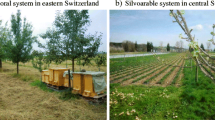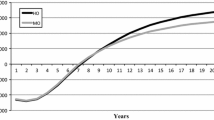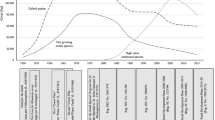Abstract
Tree plantations are widely considered a sustainable and economically feasible way to foster reforestation of degraded tropical lands. However, the greatest obstacle to their implementation is the 5–10 years period before initial returns through tree harvesting are realized. This study evaluated the feasibility of generating returns in this period by intercropping hardwood plantations with annual crops. In an agroforestry trial established in eastern Panama, the costs and revenues of intercropping five native and one exotic (Tectona grandis) tree species with three different agricultural treatments––maize-beans, pigeon pea and cassava––were assessed. All tree-crop combinations, except those with cassava, generated positive net cash flows during the first years. Over the modeled rotation period of 25 years, the agrisilvicultural systems showed up to 50 % higher net present values (NPV) than pure forestry (given a 6 % interest rate), while most tree-crop combinations exceeded the NPV of pure agriculture. T. grandis intercropped with pigeon pea showed the best economic performance. The NPVs of the agrisilvicultural systems were less sensitive to changes in costs or revenues than either pure forestry or pure agriculture. Accordingly, the final felling value required for intercropping treatments to meet the desired interest rate of 6 % was up to 90 % lower than that for pure forest plantations. This effect was strongest for native tree species, as their slower growth allowed for longer periods of intercropping. Results suggest that intercropping hardwood plantations can be an effective tool for improving financial feasibility of reforestation while providing increased food security in rural areas.






Similar content being viewed by others
Notes
The year of plantation establishment is defined as year zero and is not discounted.
References
Akindele S, Onyekwelu J (2011) Review silviculture in secondary forests. In: Günter S, Weber M, Stimm B, Mosandl R (eds) Silviculture in the tropics, vol 8. Springer, Berlin Heidelberg, pp 351–367
ANAM (2010) Guía Técnica de la Reforestación en Panamá. (Manual for the Reforestation in Panama). Autoridad Nacional del Ambiente, Panama
ANAM (2011) Atlas Ambiental de la Republica de Panamá. Autoridad Nacional del Ambiente; Gobierno Nacional de la Rebública de Panamá, Panama
Berdegué JA, Fuentealba R (eds) (2011) Latin America: The state of smallholders in agriculture. Paper presented at the IFAD Conference on New Directions for Smallholder Agriculture 24–25 January, 2011
Bremer L, Farley K (2010) Does plantation forestry restore biodiversity or create green deserts? A synthesis of the effects of land-use transitions on plant species richness. Biodivers Conserv 19(14):3893–3915. doi:10.1007/s10531-010-9936-4
Buongiorno J, Gilless JK (2003) Decision methods for forest resource management. Academic Press, Amsterdam
Castro L, Calvas B, Hildebrandt P, Knoke T (2012) Avoiding the loss of shade coffee plantations: how to derive conservation payments for risk-averse land-users. Agrofor Syst 1-17. doi: 10.1007/s10457-012-9554-0
Ceccon E (2008) Production of bioenergy on small farms: a two-year agroforestry experiment using Eucalyptus urophylla intercropped with rice and beans in Minas Gerais, Brazil. New For 35(3):285–298
Chamshama SAO, Monela GC, Sekiete KEA, Persson A (1992) Suitability of the taungya system at North Kilimanjaro forest plantation, Tanzania. Agrofor Syst 17(1):1–11. doi:10.1007/BF00122924
Chazdon R (2008) Beyond deforestation: restoring forests and ecosystem services on degraded lands. Science 320(5882):1458–1460
Condit R, Sautu A (2001) Cultivo de Arboles Nativos de Panamá: Recolección, Germinación, Viabilidad de Semillas y Crecimiento de Plántulas de ESpecies Poco Conocidas. Proyecto de Investigación. Center for Tropical Forest Science, Panama City, Panama
Coomes OT, Grimard F, Potvin C, Sima P (2008) The fate of the tropical forest: carbon or cattle? Ecol Econ 65(2):207–212. doi:10.1016/j.ecolecon.2007.12.028
Cordero J, Boshier D (eds) (2003) Árboles de Centroamérica: un Manual para Extensionistas (Trees of Central America: a Manual for Extentionists). Oxford Forestry Institute and CATIE (Centro Agronómico Tropical de Investigación y Enseñanza)
Craven D, Hall J, Verjans J (2009) Impacts of herbicide application and mechanical cleanings on growth and mortality of two timber Species in Saccharum spontaneum grasslands of the Panama canal watershed. Restor Ecol 17(6):751–761. doi:10.1111/j.1526-100X.2008.00408.x
Cubbage F, Koesbandana S, Mac Donagh P, Rubilar R, Balmelli G, Olmos VM, De La Torre R, Murara M, Hoeflich VA, Kotze H, Gonzalez R, Carrero O, Frey G, Adams T, Turner J, Lord R, Huang J, MacIntyre C, McGinley K, Abt R, Phillips R (2010) Global timber investments, wood costs, regulation, and risk. Biomass Bioenergy 34(12):1667–1678. doi:10.1016/j.biombioe.2010.05.008
Cubbage F, Glenn V, Paul Mueller J, Robison D, Myers R, Luginbuhl J, Myers R (2012) Early tree growth, crop yields and estimated returns for an agroforestry trial in Goldsboro, North Carolina. Agrofor Syst 86(3):323–334. doi:10.1007/s10457-012-9481-0
Current D (1995) Economic and institutional analysis of projects promoting on-farm tree planting in Costa Rica. In: costs, benefits, and farmer adoption of agroforestry. Project experience in Central America and the Caribbean. World Bank––The World Bank Environment Paper, Washington, pp 45–80
Current D, Lutz E, Scherr S (1995) Costs, benefits, and farmer adoption of agroforestry. In: costs, benefits, and farmer adoption of agroforestry. Project experience in Central America and the Caribbean. World Bank––The World Bank Environment Paper, Washington, pp 1–27
Daniel JN, Ong CK (1990) Perennial pigeonpea: a multi-purpose species for agroforestry systems. Agrofor Syst 10(2):113–129. doi:10.1007/BF00115360
Detlefsen G, Scheelje M (2012) Las normativas legales y el aprovechamiento de la madera en fincas. In: Detlefsen G, Somarriba E (eds) Producción de madera en sistemas agroforestales de Centroamérica. Centro Agronómico Tropical de Investigación y Ensenanza (CATIE), Turrialba, Costa Rica, pp 211–242
Ding S, Su P (2010) Effects of tree shading on maize crop within a Poplar-maize compound system in Hexi Corridor oasis, northwestern China. Agrofor Syst 80(1):117–129. doi: 10.1007/s10457-010-9287-x
ETESA (2011) Historical data on mean annual temperature and rainfall in Tortí (1977–2011). http://www.hidromet.com.pa/clima_historicos.php Accessed on 13 February 2013
Evans J, Turnbull JW (2004) Plantation forestry in the tropics. The role, siviculture, and use of planted forests for industrial, social, environmental and agroforestry purposes, 3rd edn. Oxford Univ. Press, Oxford [u.a.]
Ewers L (2013) A Literature and interview based approach to identify less known understory species for the enrichment of different shade stages of agroforestry systems in Panama. Technische Universität München. http://mediatum.ub.tum.de/doc/1178390/1178390.pdf
FAO (2002) Teak (Tectona grandis) in Central America. Forest plantations working papers, FP/19. Food and Agriculture Organization of the United Nations (FAO), Rome
Fischer A, Vasseur L (2000) The crisis in shifting cultivation practices and the promise of agroforestry: a review of the Panamanian experience. Biodivers Conserv 9(6):739–756
ForestFinance (2012) Inventory data provided by ForestFinance group. Panama city. Panama
Franzel S (2005) Financial analysis of agroforestry practices: fodder shrubs in Kenya, woodlots in Tanzania, and improved fallows in Zambia. In: Alavalapati JR, Mercer DE (eds) Valuing agroforestry systems. Springer+Business Media Inc, New York, pp 9–37
Friday JB, Fownes JH (2002) Competition for light between hedgerows and maize in an alley cropping system in Hawaii, USA. Agrofor Syst 55(2):125–137. doi: 10.1023/A%3A1020598110484
Garen E, Saltonstall K, Slusser J, Mathias S, Ashton M, Hall J (2009) An evaluation of farmers’ experiences planting native trees in rural Panama: implications for reforestation with native species in agricultural landscapes. Agrofor Syst 76(1):219–236
Glover JD, Reganold JP, Cox CM (2012) Agriculture: plant perennials to save Africa’s soils. Nature 489(7416):359–361. doi:10.1038/489359a
Goers L, Lawson J, Garen E (2012) Economic drivers of tropical deforestation for agriculture. In: Ashton MS, Tyrrell ML, Spalding D, Gentry B (eds) Managing forest carbon in a changing climate. Springer, Netherlands, pp 305–320
Gómez M (1995) Economic and institutional analysis of agroforestry projects in Panama. In: Costs, benefits, and farmer adoption of agroforestry. Project Experience in Central America and the Caribbean. World Bank––The World bank environment paper, Washington, pp 146–162
Graves AR, Burgess PJ, Palma JHN, Herzog F, Moreno G, Bertomeu M, Dupraz C, Liagre F, Keesman K, van der Werf W, de Nooy AK, Van den Briel JP (2007) Development and application of bio-economic modelling to compare silvoarable, arable, and forestry systems in three European countries. Ecol Eng 29(4):434–449. doi:10.1016/j.ecoleng.2006.09.018
Griess VC, Knoke T (2011) Can native tree species plantations in Panama compete with Teak plantations? An economic estimation. N Forests 41(1):13–39. doi:10.1007/s11056-010-9207-y
Griscom HP, Ashton MS (2011) Restoration of dry tropical forests in Central America: a review of pattern and process. The ecology and ecosystem services of native trees: implications for reforestation and land restoration in Mesoamerica. For Ecol Manag 261(10):1564–1579. doi: 10.1016/j.foreco.2010.08.027
Günter S, Weber M, Erreis R, Aguirre N (2007) Influence of distance to forest edges on natural regeneration of abandoned pastures: a case study in the tropical mountain rain forest of Southern Ecuador. Eur J For Res 126(1):67–75. doi:10.1007/s10342-006-0156-0
Günter S, Cabrera O, Weber M, Stimm B, Zimmermann M, Fiedler K, Knuth J, Boy J, Wilcke W, Iost S, Makeschin F, Werner F, Gradstein SR, Mosandl R (2008) Natural forest management in neotropical mountain rain forests—an ecological experiment. In: Beck E, Bendix J, Kottke I, Makeschin F, Mosandl R, Caldwell MM, Heldmaier G, Jackson RB, Lange OL, Mooney HA, Schulze E, Sommer U (eds) Gradients in a tropical mountain ecosystem of Ecuador, vol 198. Springer, Berlin Heidelberg, pp 347–359
Haggar J, Rheingans R, Arroyo P, Alvarado B (2003) Benefits and costs of intercropping reforestation in the Atlantic lowlands of Costa Rica. N For 25(1):41–48
Hänsela G, Ibrahimb M, Villanuevab C, Andrade H (2009) Expoliting synergies between silvopastoral system components for carbon sequestration and an increase in cattle productivity: experience from Costa Rica and Nicaragua. XIII World Forestry Congress, 18–23 October 2009, Buenos Aires, Argentina
Hazlett DMJ (1980) El crecimiento de 27 especies maderables en plantaciones de Lancetilla, Honduras. Report. Escuela Nacional de Sciencias Forestales, Honduras
IDIAP (2006) Zonificación de suelos de Panamá por niveles de nutrientes. Instituto de Investigación Agropecuaria de Panamá. http://bdigital.binal.ac.pa/bdp/descarga.php?f=idiap1.pdf. Accessed March 2014
INEC (2011) VII Censo Nacional Agropecuario 2011. Resultados Finales Básicos. Instituto Nacional de Estadística y Censo, Contraloría General de la República de Panamá
IUCN (2012) IUCN Red List of Threatened Species. Version 2012.2. http://www.iucnredlist.org/technicaldocuments/red-list-documents. Accessed March 2014
Jordan CF (ed) (1992) Taungya. Forest plantations with agriculture in Southeast Asia. CAB International, Wallingford
Jose S (2009) Agroforestry for ecosystem services and environmental benefits: an overview. Agrofor Syst 76(1):1–10. doi:10.1007/s10457-009-9229-7
Kalame FB, Aidoo R, Nkem J, Ajayie OC, Kanninen M, Luukkanen O, Idinoba M (2011) Modified taungya system in Ghana: a win–win practice for forestry and adaptation to climate change? Environ Sci Policy 14(5):519–530. doi:10.1016/j.envsci.2011.03.011
Kanninen M, Pérez D, Montero M, Víquez E (2004) Intensity and timing of the first thinning of Tectona grandis plantations in Costa Rica: results of a thinning trial. For Ecol Manag 203(1–3):89–99
Kapp G, Beer J (1995) A comparison of agrisilvicultural systems with plantation forestry in the Atlantic lowlands of Costa Rica. Agrofor Syst 32:207–223
Knoke T, Calvas B, Aguirre N, Roman-Cuesta RM, Günter S, Stimm B, Weber M, Mosandl R (2009) Can tropical farmers reconcile subsistence needs with forest conservation? Front Ecol Environ 7(10):548–554
Knoke T, Román-Cuesta RM, Weber M, Haber W (2012) How can climate policy benefit from comprehensive land-use approaches? Front Ecol Environ 10(8):438–445. doi:10.1890/110203
Knoke T, Calvas B, Moreno SO, Onyekwelu JC, Griess VC (2013) Food production and climate protection—What abandoned lands can do to preserve natural forests. Glob Environ Change 23(5):1064–1072. doi:10.1016/j.gloenvcha.2013.07.004
Kreuzer S (2013) Untersuchungen zur Konkurrenz sowie zur Interaktion zwischen Cajanus Cajan und sechs verschiedenen tropischen Wertholzarten in Panama. Master Thesis, Technische Universität München
Lamb A (1968) Cedrela odorata. Fast growing timber trees of the lowland tropics, vol 2. Commonwealth Forestry Institute, Oxford
Love B, Spaner D (2005) A survey of small-scale farmers using trees in pastures in Herrera Province, Panama. J Sustain For 20(3):37–65
Maraseni T, Cockfield G, Cadman T, Chen G, Qu J (2012) Enhancing the value of multiple use plantations: a case study from southeast Queensland, Australia. Agrofor Syst 86(3):451–462. doi:10.1007/s10457-012-9506-8
Martin FS, van Noordwijk M (2011) Is native timber tree intercropping an economically feasible alternative for smallholder farmers in the Philippines? Aust J Agric Resour Econ 55(2):257–272. doi:10.1111/j.1467-8489.2011.00530.x
Mayhew JE, Newton AC (1998) The silviculture of mahogany. CABI Pub, Wallingford
MIDA (2011) Costo de Produccion Ano Agricola 2010–2011. Ministry of Agricultural Development. http://www.ima.gob.pa. Accessed 15 November 2012
Montagnini F, Ugalde L, Navarro C (2003) Growth characteristics of some native tree species used in silvopastoral systems in the humid lowlands of Costa Rica. Agrofor Syst 59(2):163–170. doi: 10.1023/A:1026351812036
Montero M. M, Kanninen M (2005) Terminalia amazonia. Ecología y silvicultura. Serie Técnica, Informe Técnico no. 339. CATIE, Turrialba, Costa Rica
Murgueitio E, Calle Z, Uribe F, Calle A, Solorio B (2011) Native trees and shrubs for the productive rehabilitation of tropical cattle ranching lands. For Ecol Manag 261(10):1654–1663. doi:10.1016/j.foreco.2010.09.027
ONF (2012) Precios de la madera para el I Trimestre del 2012. Oficina Nacional Forestal de Costa Rica (ONF). http://www.oficinaforestalcr.org/publicaciones-tecnicas-onf/precios-de-la-madera. Accessed November 2012
Palomeque FP (2012) Natural succession and tree plantation as alternatives for restoring abandoned lands in the Andes of Southern Ecuador: aspects of facilitation and competition. Dissertation, Technische Universität München
Paul C (2014) Timber-based agrisilvicultural systems to facilitate reforestation in Panama––a silvicultural and economic evaluation. Dissertation. Technische Universität München
Paul C, Weber M (2013) Intercropping cedrela odorata with shrubby crop species to reduce infestation with Hypsipyla grandella and improve the quality of timber. ISRN Forestry 10. doi: 10.1155/2013/637410
Pearce D, Putz FE, Vanclay JK (2003) Sustainable forestry in the tropics: panacea or folly? For Ecol Manag 172(2–3):229–247. doi:10.1016/S0378-1127(01)00798-8
Pérez D, Kanninen M (2005) Stand growth scenarios for Tectona grandis plantations in Costa Rica. For Ecol Manag 210(1–3):425–441
Piotto D, Montagnini F, Ugalde L, Kanninen M (2003) Performance of forest plantations in small and mediumsized farms in the Atlantic lowlands of Costa Rica. For Ecol Manag 175(1–3):195–204
Piotto D, Víquez E, Montagnini F, Kanninen M (2004) Pure and mixed forest plantations with native species of the dry tropics of Costa Rica: a comparison of growth and productivity. For Ecol Manag 190(2–3):359–372. doi:10.1016/j.foreco.2003.11.005
Piotto D, Craven D, Montagnini F, Alice F (2010) Silvicultural and economic aspects of pure and mixed native tree species plantations on degraded pasturelands in humid Costa Rica. N For 39:369–385
Redondo-Brenes A, Montagnini F (2006) Growth, productivity, aboveground biomass, and carbon sequestration of pure and mixed native tree plantations in the Caribbean lowlands of Costa Rica. For Ecol Manag 232(1–3):168–178. doi:10.1016/j.foreco.2006.05.067
Reid WVC (2005) Ecosystems and human well-being. General synthesis: a report of the Millennium ecosystem assessment. Island Press, Washington
Sands R (2005) Forestry in a global context. CABI Pub, Wallingford
Schlönvoigt A, Beer J (2001) Initial growth of pioneer timber tree species in a Taungya system in the humid lowlands of Costa Rica. Agrofor Syst 51(2):97–108. doi:10.1023/A:1010674402907
Schuchmann J (2011) A participatory survey on current integration of trees on farms and pastures within land use systems in the township of Tortí in Panama. Bachelor Thesis, Technische Universität München
Sloan S (2008) Reforestation amidst deforestation: simultaneity and succession. Globalisation and environmental governance: is another world possible? Glob Environ Change 18(3):425–441
Swallow SK, Parks PJ, Wear DN (1990) Policy-relevant nonconvexities in the production of multiple forest benefits. J Environ Econ Manag 19(3):264–280
Tilman D, Cassman KG, Matson PA, Naylor R, Polasky S (2002) Agricultural sustainability and intensive production practices. Nature 418(6898):671–677. doi:10.1038/nature01014
Tschakert P, Coomes OT, Potvin C (2007) Indigenous livelihoods, slash-and-burn agriculture, and carbon stocks in Eastern Panama. Ecol Econ 60(4):807–820
Vieira DLM, Holl KD, Peneireiro FM (2009) Agro-successional restoration as a strategy to facilitate tropical forest recovery. Restor Ecol 17(4):451–459. doi:10.1111/j.1526-100X.2009.00570.x
Wadsworth F (ed) (1960) Datos de crecimiento de plantaciones forestales en México, Indias Occidentales y Centro y Sur América. Carribean Forester 21
Waltenberger W (2013) Characterization of crown structures and light conditions in stands of six different tree species along a gradient of age and planting distance in Panama and their relevance for agroforestry systems. Master Thesis, Technische Universität München
Watanabe H (1992) Tree-crop interactions in Taungya Plantations. In: Jordan CF (ed) Taungya. Forest plantations with agriculture in Southeast Asia. CAB International, Wallingford, pp 32–43
Whitmore JL (1978) Cedrela provenance trial in Puerto Rico and St. Croix; establishment phase. USDA Forest Service, Research Note ITF-16. Institute of Tropical Forestry, Rio Piedras, Puerto Rico
Witcomb M, Dorward P (2009) An assessment of the benefits and limitations of the shamba agroforestry system in Kenya and of management and policy requirements for its successful and sustainable reintroduction. Agrofor Syst 75(3):261–274. doi:10.1007/s10457-008-9200-z
Acknowledgments
This research was funded by the German Research Foundation (DFG) (Project WE 2069/6-1). C. Paul was supported by both, the Elite Network of Bavaria and the program, “Equal Opportunity for Women in Research and Teaching”, at the Technische Universität München. C. Paul and V.C. Griess received additional support from the TUM Graduate School Thematic Graduate Center at the Technische Universität München. The authors are grateful to the Forest Finance Group for providing land and labor to the project and to BARCA SA for logistical help. The authors also wish to thank T. Knoke for valuable suggestions during the whole project phase and Laura Carlson for language editing of the manuscript.
Author information
Authors and Affiliations
Corresponding author
Electronic supplementary material
Below is the link to the electronic supplementary material.
Rights and permissions
About this article
Cite this article
Paul, C., Griess, V.C., Havardi-Burger, N. et al. Timber-based agrisilviculture improves financial viability of hardwood plantations: a case study from Panama. Agroforest Syst 89, 217–235 (2015). https://doi.org/10.1007/s10457-014-9755-9
Received:
Accepted:
Published:
Issue Date:
DOI: https://doi.org/10.1007/s10457-014-9755-9




